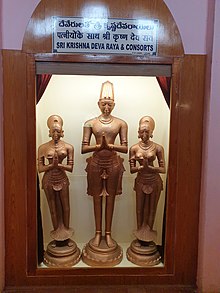
Back كريشنادفاريا Arabic كريشنادفاريا ARZ কৃষ্ণদেবরায় Bengali/Bangla Krišnadéva Ráj Czech Krishna Deva Raya Spanish Krishna Deva Raya Finnish Krishna Deva Raya French कृष्णदेवराय Hindi Krishnadevaraya ID Kṛṣṇadevarāya Italian
| Krishnadevaraya | |
|---|---|
| Maharajadhiraja Kannada Rajya Rama Ramana Andhra Bhoja Dakshinasamudradhiswara Mooru Rayara Ganda[1] Abhinava-Bhoja[2] Gaubrahmana Pratipalaka | |
 Sculpture of Krishnadevaraya and his wives at Chandragiri Museum | |
| Vijayanagara Emperor | |
| Reign | 26 July 1509 – 17 October 1529[3] |
| Coronation | 23/24 January 1510[4][a] |
| Predecessor | Viranarasimha Raya |
| Successor | Achyuta Deva Raya |
| Born | 17 January 1471 Vijayanagara, Vijayanagara Empire (modern day Hampi, Karnataka, India) |
| Died | 17 October 1529 (aged 58) Vijayanagara, Vijayanagara Empire (modern day Hampi, Karnataka, India) |
| Consort | Tirumala Devi Chinna Devi Annapurna Devi |
| Issue | |
| Dynasty | Tuluva |
| Father | Tuluva Narasa Nayaka |
| Mother | Nagala Devi |
| Religion | Sri Vaishnavism |

Krishnadevaraya (17 January 1471 – 17 October 1529) was emperor of the Vijayanagara Empire from 1509 to 1529. He was the third monarch of the Tuluva dynasty, and is considered to be one of the greatest rulers in Indian history.[7] He ruled the largest empire in India after the fall of the Islamic Delhi Sultanate.[8] Presiding over the empire at its zenith, he is regarded as an icon by many Indians. Krishnadevaraya earned the titles Andhra Bhoja (lit. "Bhoja of Andhra"), Karnatakaratna Simhasanadeeshwara (lit. "Lord of the Jewelled Throne of Karnataka"), Yavana Rajya Pratistapanacharya (lit. "Establishment of the King to Bahmani Throne"), Kannada Rajya Rama Ramana (lit. "Lord of the Kannada Empire), Gaubrahmana Pratipalaka (lit. "Protector of Brahmins and Cows") and Mooru Rayara Ganda (lit. "Lord of Three Kings"). He became the dominant ruler of the peninsula by defeating the sultans of Bijapur, Golconda, the Bahmani Sultanate and the Gajapatis of Odisha, and was one of the most powerful Hindu rulers in India.[1]
Krishnadevaraya's rule was characterised by expansion and consolidation. This was the time when the land between the Tungabhadra and Krishna river (the Raichur doab) was acquired (1512), ruler of Odisha were subdued (1514) and severe defeats were inflicted on the Sultan of Bijapur (1520).
When the Mughal Emperor Babur was taking stock of the potentates of north India, he rated Krishnadevaraya the most powerful, with the most extensive empire in the subcontinent.[8] The Portuguese travellers Domingo Paes and Duarte Barbosa visited the Vijayanagara Empire during his reign, and their travelogues indicate that the king was not only an able administrator but also an excellent general, leading from the front in battle and even attending to the wounded. On many occasions, the king changed battle plans abruptly, turning a losing battle into victory. The poet Mukku Timmanna praised him as the 'Destroyer of the Turks.'[9] Krishnadevaraya benefited from the counsel of his prime minister Timmarusu, whom he regarded as the father figure responsible for his coronation. Krishnadevaraya was also advised by the witty Tenali Ramakrishna, who was employed in his court.
- ^ a b Advanced Study in the History of Medieval India by Jl Mehta p. 118
- ^ Pollock, Sheldon (2003). The Language of the Gods in the World of Men: Sanskrit, Culture, and Power in Premodern India. University of California Press. p. 179. ISBN 0-5202-4500-8.
- ^ Srinivasan, C. R. (1979). Kanchipuram Through the Ages. Agam Kala Prakashan. p. 200. OCLC 5834894. Retrieved 25 July 2014.[ISBN missing]
- ^ Sewell, R. (1915). "The Kings of Vijayanagara, A.D. 1486-1509". The Journal of the Royal Asiatic Society of Great Britain and Ireland. [Cambridge University Press, Royal Asiatic Society of Great Britain and Ireland]: 383–395. ISSN 0035-869X. JSTOR 25189336. Retrieved 22 October 2024.
- ^ Sivasankaranarayana, Bh.; Rajagopal, M. V.; Ramesan, N. (1970). Andhra Pradesh District Gazetteers: Anantapur. Director of Print. and Stationery at the Government Secretariat Press, copies can be had from:Government Publication Bureau. p. 63.[ISBN missing]
- ^ T. K. T. Viraraghavacharya (1997). History of Tirupati: The Thiruvengadam Temple, Volume 2. Tirumala Tirupati Devasthanams. p. 469.
- ^ Tabasum Bhanu (2015) Sri krishnadevaraya 1509-1529.made vijayanagara a military power in the south an overview IJCRT 3(4)
- ^ a b Keay, John, India: A History, New York: Harper Collins, 2000, p. 302
- ^ Vijayanagara Voices: Exploring South Indian History and Hindu Literature William Joseph Jackson: p. 124
Cite error: There are <ref group=lower-alpha> tags or {{efn}} templates on this page, but the references will not show without a {{reflist|group=lower-alpha}} template or {{notelist}} template (see the help page).